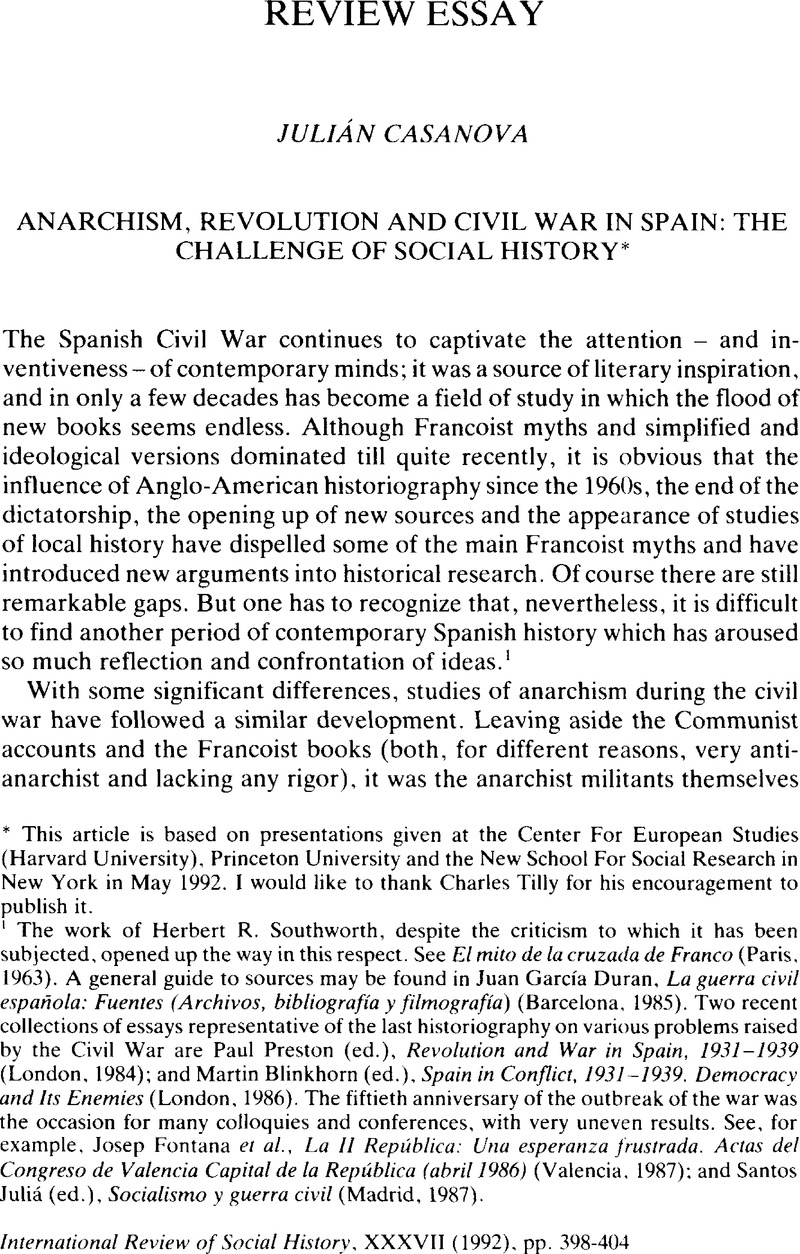Article contents
Anarchism, Revolution and Civil War in Spain: The Challenge of Social History*
Published online by Cambridge University Press: 18 December 2008
Abstract

- Type
- Review Essay
- Information
- Copyright
- Copyright © Internationaal Instituut voor Sociale Geschiedenis 1992
References
1 The work of Herbert R. Southworth, despite the criticism to which it has been subjected, opened up the way in this respect. See El mito de la cruzada de Franco (Paris, 1963).Google Scholar A general guide to sources may be found in Duran, Juan García, La guerra civil española: Fuentes (Archivos, bibliografía y filmografla) (Barcelona, 1985).Google Scholar Two recent collections of essays representative of the last historiography on various problems raised by the Civil War are Preston, Paul (ed.), Revolution and War in Spain, 1931–1939 (London. 1984);Google Scholar and Blinkhorn, Martin (ed), Spain in Conflict, 1931–1939. Democracy and Its Enemies (London. 1986).Google Scholar The fiftieth anniversary of the outbreak of the war was the occasion for many colloquies and conferences, with very uneven results. See, example, Josep, Fontana et al. , La II República: Una esperanza frustrada. Actas Congreso de Valencia Capital de la Reptública (abril 1986) (Valencia, 1987):Google Scholar and Santos, Juliá (ed.), Socialismo y guerra civil (Madrid, 1987).Google Scholar
2 Horacio, Martinez Prieto, El anarquismo español en la lucha política (Paris, 1966);Google Scholar and Juan, García Oliver, El eco de los pasos (Barcelona, 1978).Google Scholar
3 Peirats, Jose, La CNT en la Revolución española, 3 vols (Paris, 1971).Google Scholar At the same time. César M. Lorenzo. Horacio Martínez Prieto's son, wrote the first serious reflection about power, one of the riskiest subjects in the anarchist literature. See César, M. Lorenzo. Los anarquistas españoles y el poder, 1868–1969 (Paris, 1972).Google Scholar
4 The contemporary account of Borkenau, Franz, The Spanish Cockpit (London, 1937), was published in Spanish in 1971 (in Paris). The Spanish Labyrinth,Google Scholar by Brenan, Gerald, had to wait twenty years before a Spanish edition appeared (Paris, 1962).Google Scholar Examples of that Anglo-American historiography on the war are Thomas, Hugh, The Spanish Civil War (New York, 1961);Google Scholar and Jackson, Gabriel, The Spanish Republic and the Civil War, 1931–1939 (Princeton, N.J., 1965).Google Scholar On anarchism see Bolloten, Burnett, The Grand Camouflage: the Communist Conspiracy in the Spanish Civil War (New York, 1961) (published later in more extensive versions under The Spanish Revolution, 1971, and The Civil War, 1991);Google Scholar and Brademas, John, Anarcosindicalismo y revolución en España (1930–1937) (Barcelona, 1974).Google Scholar An entirely different way of approaching those events, from the perspective made possible by oral history. may be seen in Fraser, Ronald, Blood of Spain: The Experience of Civil War (Harmondsworth, 1981).Google Scholar A good critical analysis of that Anglo-American historiography was provided by Santos, Juliá, “Segunda Republica: por otro objeto de investigación”, in Manuel, Tuñón de Lara et al. , Historiografía española contemporádnea (Madrid, 1980), pp. 295–313.Google Scholar
5 For the first see Paniagua, Xavier, La sociedad libertaria: Agrarismo e industrialización en el anarquismo español (1930–1939) (Barcelona, 1982).Google Scholar For the second see Garrido, Luis, Colectividades agrarias en Andalucía: Jaén (1931–1939) (Madrid, 1976);Google ScholarBosch, Aurora, Ugetistas y libertarios. Guerra civil y revolución en el País Valenciano, 1936–1939 (Valencia, 1983);Google Scholar and Julián, Casanova, Anarquismo y revolución en la sociedad rural aragonesa, 1936–1938 (Madrid, 1985).Google Scholar A combination of both may be found in Walther, L. Bernecker, Colectividades y revolución social. El anarquismo en la guerra civil española (Barcelona, 1982).Google Scholar See also the compendium of research on peasant collectives in Julián, Casanova (ed), El sueño igualitario. Campesinado y colectivizaciones en la España republicana (Zaragoza. 1989).Google Scholar In English see also Kelsey, Graham, Anarchosyndicalism. Libertarian Communism and the State: the CNT in Zaragoza and Aragon (Amsterdam, 1991).Google Scholar
6 One of the exceptions is the already cited work Socialismo y guerra civil. The best book available about the period is, however, that by Graham, Helen, Socialism and War: the Spanish Socialist Party in Power and Crisis, 1936–1939 (Cambridge, 1991).CrossRefGoogle Scholar
7 What follows is an abridged summary fo the argument I develop in my book Anarquismo y revolución en la sociedad rural aragonesa and in other works such as “Anarquismo y guerra civil: Del poder popular a la burocracia revolucionaria”, in Juliá, , Socialismo y guerra civil, pp. 71–82; “Anarchism and Revolution in the Spanish Civil War: the Case of Aragon”, European History Quarterly, 17 (1987), pp. 423–445; “Las colectivizaciones”, in La guerra civil. Historia 16, no. 16 (1986), pp. 42–62; “Guerra y revolución: la edad de oro del anarquismo español”. Historia Social, no. 1 (1988), pp. 63–76;Google Scholar and “España, 1931–1939: República, protesta social y revolución”, in Julio, Valdeón et al. , Revueltas y revoluciones en la historia (Salamanca, 1990), pp. 135–150.Google Scholar
8 The best exposition of this thesis is provided by Santos Juliá, “De la división orgánica al gobierno de unidad nacional”, in Juliá, , Socialismo y guerra civil, pp. 231–238.Google Scholar
9 This was also the case in Germany and Italy at the end of the Great War and some authors think that that explains the failure of revolution there. See, for instance, Geary, Dick. European Labour Protest, 1848–1939 (London. 1984), p. 163.Google Scholar
10 On anticlericalism, see Lincoln, Bruce, “Revolutionary Exhumation in Spain, July 1936”, Comparative Studies in Society and History, XXVII (1985) pp. 241–260.CrossRefGoogle Scholar See the general interpretation of that phenomenon in Joan, Connelly Ullman, “The Warp and Woof of Parliamentary Politics in Spain, 1808–1939: Anticlericalism versus ‘Neo-Ca-tholicism’ ”, European Studies Review, XIII (1983), pp. 145–176.Google Scholar On Durruti see, for example. Paz, Abel, Durruti en la revolución española (Barcelona, 1986).Google Scholar
11 See the works of Barrington Moore, Theda Skocpol and Charles Tilly. For a good, recent analysis see Aya, Rod, Rethinking Revolutions and Collective Violence. Studies on Concept, Theory and Method (Amsterdam. 1990). I have discussed the need for a rapprochement between historical sociology and theoretical history in my book La historia social y los historiadores (Barcelona. 1991).Google Scholar
- 2
- Cited by




